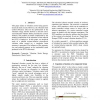Free Online Productivity Tools
i2Speak
i2Symbol
i2OCR
iTex2Img
iWeb2Print
iWeb2Shot
i2Type
iPdf2Split
iPdf2Merge
i2Bopomofo
i2Arabic
i2Style
i2Image
i2PDF
iLatex2Rtf
Sci2ools
CSREAESA
2006
2006
Piezoelectric-based Vibration Control in Composite Structures
ct This paper relates to vibration control using passive electrical shunt circuits. However, the vibration shunt control efficiency relies on the optimization of the vibration energy transfer between a structure and a Lead-Zirconate-Titanate (PZT) piezoelectric ceramic material. The problem is further complicated by the material composition of the substrate or host material the PZT is coupled to. In this paper, an analytical study of a parallel resistor-inductor piezoelectric vibration shunt control on a composite beam structure is presented. The influence of the geometry size and material property on the mechanical strain produced in the PZT is discussed.
CSREAESA 2006 | CSREAESA 2007 | Piezoelectric Vibration Shunt | Shunt Control Efficiency | Vibration Shunt Control |
| Added | 30 Oct 2010 |
| Updated | 30 Oct 2010 |
| Type | Conference |
| Year | 2006 |
| Where | CSREAESA |
| Authors | Jialong Cao, Sabu John, Tom Molyneaux |
Comments (0)

